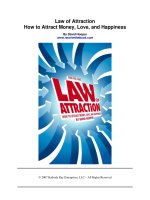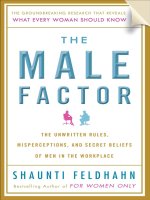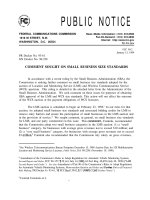Notes on Influencer by Kerry Patterson_2 pptx
Bạn đang xem bản rút gọn của tài liệu. Xem và tải ngay bản đầy đủ của tài liệu tại đây (765.48 KB, 21 trang )
The Power to Change Anything 11
And here’s what qualifies these remarkable individuals as
master change agents rather than as merely lucky. They have
all successfully applied their influence strategies to problems
that others haven’t been able to solve for years—often centuries.
None has succeeded through serendipity, nor have any of their
results been idiosyncratic. Through years of careful research
and studied practice, they’ve developed a handful of powerful
influence principles and strategies that they themselves can and
do replicate and that others can and do learn.
This book shares their combined knowledge. By sharing the
principles and strategies of a handful of brilliant influencers,
we (the authors) hope to help you expand your own sphere of
influence—and thus change your own life for good.
In this book you’ll meet a few of the influencers who are
changing the world.
This page intentionally left blank
13
1
You’re an Influencer
I wanted the influence. In the end I wasn’t very good
at being a [university] president. I looked out of the window
and thought that the man cutting the lawn actually
seemed to have more control over what he was doing.
—Warren Bennis
T
o get a glimpse of what it takes to exert profound influ-
ence, to literally change anything, we first travel to San
Francisco and look in on influence master Dr. Mimi
Silbert. Consider what Silbert has been able to do by applying
the best of today’s influence strategies to one of today’s most
noxious problems. She is the founder of the Delancey Street
Foundation, a one-of-a-kind organization with headquarters at
an upscale address on San Francisco’s Embarcadero. Silbert’s
company is part corporate conglomerate and part residential
therapy. It consists of several dozen businesses, all headed by
Silbert.
What’s unique about the institution is the employee pop-
ulation. In Silbert’s words, “They’re nasty, racist, violent, and
greedy. They’re thieves, prostitutes, robbers, and murderers.”
Then she adds: “When we started 30 years ago, most were gang
members. Today many are third-generation gang members.”
According to Silbert, “These guys get letters from Grandma say-
ing, ‘Get back here—the gang needs you!’ ”
Copyright © 2008 by VitalSmarts, LLC. Click here for terms of use.
14 INFLUENCER
Dr. Silbert’s typical new hires have had four felony convic-
tions. They’ve been homeless for years, and most are lifetime
drug addicts. Within hours of joining Delancey, they are work-
ing in a restaurant, moving company, car repair shop, or one
of the many Delancey companies. And other than Silbert her-
self, these felons and addicts make up the entire population at
Delancey. No therapists. No professional staff. No donations,
no grants, no guards—just a remarkable influence strategy that
has profoundly changed the lives of 14,000 employees over the
past 30 years. Of those who join Delancey, over 90 percent
never go back to drugs or crime. Instead they earn degrees,
become professionals, and change their lives. Forever.
MEET JAMES
One of the employees we met is a well-scrubbed, affable but
steely-eyed fellow we’ll call James. James’s story is typical of Sil-
bert’s staff. Like many of the 500 residents living on the San
Francisco campus, James was a career criminal and drug addict
before coming to Delancey. And like most, he started young.
After four years as a regular runaway, criminal, and drug abuser,
James turned 10. By that time Illinois was fed up with his
shenanigans and had tracked down James’s father—who aban-
doned him at age one. State justice authorities wished James
good luck as they stood at a gate at the O’Hare airport while
making sure he understood that he was no longer welcome in
Chicago.
James flew to Oakland, California, where he took up resi-
dence with his father near the docks. The first lesson his dear
old dad taught him was how to shoot heroin. The next 25 years
consisted of an uninterrupted period of violent crime, drug
abuse, and prison time. Six years ago he was convicted of yet
another violent offense and sentenced to 18 years with no hope
of parole for 16 years. That’s when he asked to join Delancey
rather than serve his full sentence.
You’re an Influencer 15
James changed in ways that are hard to imagine. When we
first visited Delancey, he was professionally dressed and had not
used drugs or alcohol in two years. To learn how Dr. Silbert
influences this kind of change, we touch base with her work
throughout this book. She draws from the principles and prac-
tices of every one of the influence geniuses we’ve studied to date.
Combining principles learned in Tanzania, practices honed
in Mexico City, and theories developed in Palo Alto helps us
understand how Ralph Heath in Marietta, Georgia, was able to
influence the behavior of 4,500 engineers and craftsmen to move
a stalled product from design to production, resulting in billions
of dollars in needed sales; why Mike Miller was able to change
the culture of a massive IT group in order to dramatically
improve performance; and what makes it possible for an individ-
ual who has struggled to lose weight for years to finally turn the
corner. But most importantly, these proven concepts, principles,
and theories will help you, your family, your company, and your
community develop an influence repertoire of enormous power.
SOME AMAZING CASES
Leaving San Francisco for warmer climes and more far-
reaching methods, we head to Mexico City to visit TV pro-
ducer Miguel Sabido. He has created a method for influenc-
ing hundreds of thousands of people at a time.
Sabido has perfected strategies for changing how people
think and behave by producing life-changing soap operas—of
all things. At one point, when Sabido aimed his popular TV
show Ven Conmigo (“Come with Me”) at improving literacy
(a problem that had remained intractable for decades), his TV
characters propelled over a quarter of a million viewers into the
streets of Mexico City—all in search of free literacy booklets
that were shown on the program. Sabido’s work in entertain-
ment education has now been replicated in dozens of coun-
tries with remarkable success. A careful review of his work helps
16 INFLUENCER
us understand how to use one of the world’s best tools for help-
ing others willingly change their minds.
Switching our attention to Ithaca, New York, we see Brian
Wansink explore how the physical world can either help or
hinder people in their quest to shed unwanted pounds. By
learning how Wansink and others enlist the “curious power of
propinquity,” we are able to apply the same methods to, say,
propel your kids to read more books, or encourage coworkers
to collaborate.
To learn how to develop one of the most important of all
influence methods, we travel to Atlanta, Georgia, and meet Dr.
Donald Hopkins and his staff at The Carter Center. Their work
across Africa and Asia teaches us how to identify a handful of
vital behaviors that help change the habits of millions of peo-
ple. In this case, he and his colleagues help change the dan-
gerous water-drinking habits of millions of remote villagers.
Hopkins’s work on applying principles of “positive deviance”
helps us all understand what it takes to discover a handful of
high-leverage behaviors that drive virtually every change effort
we’ll ever undertake.
Try this for a challenge. Since 1986, Dr. Hopkins and his
team at The Carter Center in Atlanta have focused on the erad-
ication of the Guinea worm disease. The Guinea worm is one
of the largest human parasites (it can grow to three feet long),
and it has caused incalculable pain and suffering in millions
of people. When West Asian and sub-Saharan villagers drink
stagnant and unfiltered water, they take in the larvae of Guinea
worms, which then burrow into abdominal tissues and slowly
grow into enormous worms.
Eventually the worms begin to excrete an acidlike sub-
stance that helps carve a path out of the host human’s body.
Once the worm approaches the skin’s surface, the acid causes
painful blisters. To ease the horrific pain, victims rush to the
local water source and plunge their worm-infected limbs into
the pond for cooling relief. This gives the worm what it
You’re an Influencer 17
wanted—access to water in which to lay hundreds of thousands
of eggs, thus continuing the tragic cycle.
Sufferers cannot work their crops for many weeks. When
parents are afflicted, their children may drop out of school to
help out with chores. Crops cannot be cultivated. The harvest
is lost. Starvation ensues. The cycle of illiteracy and poverty
consumes the next generation. Often, secondary infections
caused by the worm can kill. Consequently, for over 3,500 years
the Guinea worm has been a major barrier to economic and
social progress in dozens of nations.
In 1986 Dr. Hopkins and his colleagues declared war on
the worm. Hopkins was interested in this particular disease
because he knew that if 120 million people in 23,000 villages
would change just a few vital behaviors for just one year, there
would never be another case of the infection. Ever. But imag-
ine the audacity of intending to influence such a scattered pop-
ulation in so many countries—frequently faced with corrupt or
nonexistent health systems or fragile political stability.
And yet this is exactly what Hopkins’s team has done. Soon
he and his colleagues will have laid claim to something
never before accomplished in human history. They will
have eradicated a global disease without finding a cure. Despite
this enormous disadvantage, Hopkins and his small band of
intrepid change agents will have beaten the disease with noth-
ing more than the ability to influence human thought and
action.
The implications of Hopkins’s work for individuals, busi-
nesses, and communities are enormous. Everyone has a version
of a Guinea worm disease: some self-defeating behaviors that,
if changed, could unlock a whole new level of performance.
Hopkins teaches us first how to find success where others have
failed, and second, how to locate a handful of key actions that,
if routinely enacted, will guarantee our own success.
Who can’t benefit from learning how to locate strategies
that routinely succeed in the face of widespread failure?
18 INFLUENCER
STUDY WITH THE BEST SCHOLARS
Hopkins, Silbert, Sabido—in fact, virtually all the influencers
we studied—draw on the same sources: a handful of brilliant
social scientists you’ll meet in this book. For now, let’s meet the
one almost all cited as the scholar of scholars: Albert Bandura.
He’s a genius whom influence masters routinely study. When
we first entered the offices of the practitioners we studied, most
displayed Dr. Bandura’s works on their bookshelves. His name
leaped out at us because our history with him goes back over
30 years.
We first encountered Bandura in the mid-1970s in his
modest office at Stanford University. There we met a mild-
mannered and brilliant man who was already legendary as the
father of social learning theory. When we reconnected with
him three decades later, at an energetic 83, Dr. Bandura was
still up to his neck in influence research that continues to tilt
the world. He can still lay claim to the fact that he’s the most
cited psychologist alive.
Here’s how Bandura’s work fits into the world of influence
and can be of enormous help to all of us. In his early years, Dr.
Bandura generated a remarkable body of knowledge that led
to rapid changes in behaviors that other theorists had dawdled
over for years. Phobics who’d spent years on a couch were freed
in hours. Addicts who had used drugs for decades became clean
in weeks and were well on their way to making the transforma-
tive changes in their lives that would keep them clean.
Individuals struggling with obesity for a lifetime developed new
habits in months.
One of Bandura’s classic studies demonstrated, for exam-
ple, how powerfully our behavior is shaped by observing oth-
ers. This came at a time when most psychologists believed that
behavior was solely influenced by the direct rewards and pun-
ishments people experienced. This was the age of strict behav-
iorism. And yet Bandura’s intense curiosity about how to
change human behavior made him impatient with such sim-
You’re an Influencer 19
plistic explanations. So he took a daring swing at the established
dogma and began an exodus toward a much more powerful
theory.
Seeing a rise in violence corresponding with the diffusion
of television, Bandura thought it worthwhile to examine
whether juveniles were learning violent behaviors by watching
TV characters smack, kick, and shoot one another. To explore
the effects of TV violence, Bandura and a team of graduate stu-
dents watched closely as nursery school children played in a
small room packed with toys—dolls, tiny stoves, balls, and so
forth. Among this tempting array of playthings was a “Bobo
doll”—a large plastic blow-up doll with a weight in the bottom.
If you punch the doll in the nose, it bounces right back so you
can punch it again.
Left to their own devices, children played with several of
the toys, moving from one to the next—occasionally giving
Bobo a punch or two. But what if researchers demonstrated
novel aggressive behavior for the children? Would kids learn
through simple observation? To answer this question, Bandura
showed a different group of children a short movie of a woman
modeling novel aggressive behavior. She pummeled the Bobo
doll with a mallet. She flung the plastic toy into the air, kicked
it repeatedly, and eventually sat on it and beat it. That seemed
novel enough.
The children who watched the film were then released one
at a time into the toy room. Would simple modeling influence
their behavior? You only have to watch the black-and-white
film segments taken of the experiment for a few seconds to
answer the question. A little girl wearing a dress—complete
with a 50s-style poofy petticoat—enters the room, digs through
the toys until she finds the mallet, and starts whaling on Bobo.
She and the dozens of other nursery school kids who followed
her demonstrate all the aggressive behavior they had seen
modeled—including inventive new forms of aggression such
as beating the doll with a cap gun. In Bandura’s own words,
20 INFLUENCER
“They added creative embellishments. One girl actually trans-
forms a doll into a weapon of assault.” There she is—that cute
little girl in the frilly outfit—smacking Bobo with Raggedy Ann.
In addition to demonstrating that humans are influenced
by watching the behavior of others, Bandura was able to prove
that the violence pumped out by the television networks was
likely to exact a terrible toll on viewers. Dr. Bandura caps his
review of his classic study by stating with a twinkle: “This
research didn’t get me onto the Christmas-card list of the
broadcast industry.” But it did put him smack dab in the cen-
ter of influence research.
This work, when combined with hundreds of other
Bandura studies that have been aimed at fixing an ailing world,
teaches us the very first thing we need to know about influence.
Influence strategies can indeed be studied, tested, and mas-
tered. Bandura also taught us where not to waste our time. For
instance, if you want others to change, you don’t have to put
them on a couch for 10 years to learn about their critical child-
hood moments. You also need not trouble yourself by laying a
trail of Reese’s Pieces in front of others to propel them through
a maze. Humans aren’t simple-minded pawns who can be read-
ily manipulated to do whatever you like—even if you have the
right amount of candy.
In fact, Bandura found humans to be quite complicated. It
turns out that they think. Humans observe, cogitate, draw con-
clusions, and then act. All this is important to know because if
you want to change the world, you eventually have to change
how people behave. And if you want to change how they
behave, you have to first change how they think.
WHAT THIS MEANS TO YOU
There’s good news in all of this. Since our ineffectiveness at
influencing others stems from a simple inability rather than a
character flaw or lack of motivation, the solution lies in con-
You’re an Influencer 21
tinued learning. We can become powerful influencers. We
don’t have to wait for everyone else to miraculously change. We
won’t have to constantly seek serenity.
It also means that the changes we need to make won’t be
too intrusive. We don’t need a lobotomy, a pep talk, or an infu-
sion of tenacity. Instead, we simply need to expand our self-
image by seeing ourselves as influencers; it’s the one job that
cuts across every domain of our life. In addition, like any ded-
icated person, we need to study the works of the influencers
who are already good at the job. As we learn the strategies influ-
ence masters have been implementing for the past five decades,
we’ll be in far better shape to take on the profound and per-
sistent problems that have been plaguing us for years.
Notice that we have used the word “strategies.” We’ve cho-
sen the plural because there is no one strategy—no silver
bullet—for resolving profound, persistent, and resistant prob-
lems. When it comes to the problems that have us stymied, it
takes an entire set of influence methods. We’ll help you create
your own set of tools by sharing the strategies used by every
influencer we’ve studied.
These influence strategies, by the way, are value-neutral.
They can be used either to break or to cause a heroin ad-
diction. They can be used either to create or to destroy a
customer-driven corporate culture. Naturally, the influencers
we studied routinely aimed their strategies at deserving, even
noble causes. But not everyone does or will. We knowingly
share the powerful methods of the world’s best influencers as
a way of making them both accessible and transparent. To the
degree that people understand new strategies, their ability to
make their own life better grows exponentially. To the degree
that people understand the forces that are already influencing
their behavior, they are more empowered to choose their
response.
Any one of the influence strategies we explore, combined
with what you already know, could be enough to put you on
22 INFLUENCER
the road to creating lasting change. Put into play several meth-
ods, and your chances for improvement only grow. Find a way
to combine all the methods, and you’ll be able to create
changes that most of us have only been able to imagine.
So join us as we do our best to answer: How can I learn to
change anything?
23
2
Find Vital Behaviors
It is not enough to do your best; you must
know what to do, and THEN do your best.
—W. Edwards Deming
B
efore you can influence change, you have to decide
what you’re trying to change. Influence geniuses
focus on behaviors. They’re universally firm on this
point. They don’t dive into developing influence strategies
until they’ve carefully identified the behaviors they want to
influence.
And now for the big idea: A few behaviors can drive a lot
of change.
The breakthrough discovery of most influence geniuses is
that enormous influence comes from focusing on just a few
vital behaviors. Even the most pervasive problems will often
yield to changes in a handful of high-leverage behaviors. Find
these, and you’ve found the beginning of influence.
THE KING’S BIRTHDAY PRESENT
To see how tenaciously searching for vital behaviors can make
an important difference, meet Dr. Wiwat Rojanapithayakorn
(or, as he is known around the world, Dr. Wiwat). He learned
the value of searching until you find the right behaviors the
hard way.
Copyright © 2008 by VitalSmarts, LLC. Click here for terms of use.
24 INFLUENCER
In 1988, King Rama IX of Thailand turned 60. To honor
the event, he gave the country a gift. Unfortunately, the king’s
well-intended present actually unleashed a horrendous plague
on his people. Prior to the king’s birthday, AIDS in Thailand
had been restricted to prisoners who passed the disease from
one to the other by sharing used needles. For several years the
disease stayed incarcerated with its hosts. But in 1988, in a
birthday-inspired act of compassion (in keeping with a national
tradition for momentous occasions), the king granted amnesty
to over 30,000 prisoners. Released from its confinement, the
AIDS virus celebrated its new freedom by rampaging through
a much larger intravenous drug-user community. In just a few
months almost half the users nationwide were infected.
The country’s infectious disease experts watched in horror
as month by month the disease spread from one community to
another. Close on the heels of IV drug users, sex workers fell
prey. Within only a year, as many as one-third of the sex work-
ers in some provinces tested HIV positive. Next, married men
carried the scourge home to their unsuspecting wives, who fre-
quently passed it to newborn babies. By 1993 an estimated
1 million Thais were infected with HIV. Health experts world-
wide predicted that in just a few years Thailand would lead the
world in infections per capita—with as many as one in four
adults carrying the virus.
But it never happened. Within two years the virus hit a wall,
and then it retreated. By the late 1990s—largely because of a
remarkable influence strategy implemented by Dr. Wiwat—
new infections had been cut by 80 percent. The Thai govern-
ment estimates that as of 2004, over 5 million people who
should have been infected weren’t.
But the solution didn’t come easily, and it certainly didn’t
come after the first attempt. While AIDS was taking Thailand
by storm, Dr. Wiwat battled the plague alongside a handful of
his colleagues in the Ratchaburi province. His training had
taught him that the key to fighting the spread of any disease
Find Vital Behaviors 25
lay in making the public aware of the threat. The experts who
were advising Wiwat (people who had thought about the trans-
mission problem but who hadn’t actually solved it) argued that
diseases thrive in ignorance; therefore, you have to spread the
word.
With this idea in mind, when Dr. Wiwat accepted a position
with Thailand’s Ministry of Public Health, specializing in vene-
real diseases, he approached the task of informing an ignorant
public in much the same way corporate executives try to improve
quality, customer service, or teamwork. Wiwat’s team distributed
posters. They held education sessions. They convinced celebri-
ties to broadcast television and radio spots.
Despite their best efforts, Wiwat and his teammates failed.
After a couple of exhausting, hectic, and expensive years, Thai
researchers found that they had accomplished nothing. The
problem had actually grown far worse. That’s when Wiwat
threw out the handbook. Rather than accepting the word of
people who had never actually succeeded in eliminating the
rapid transmission of the disease, Dr. Wiwat decided to con-
duct a more intensive search for a strategy. He started by por-
ing over data about the transmission cycle of AIDS through
Thailand.
It didn’t take Wiwat long to realize that 97 percent of all
new HIV infections came from heterosexual contact with sex
workers. This statistic might seem a bit odd until you learn
that Thailand has over 150,000 sex workers—about one for
every 150 adult men. Induced by low prices and a permis-
sive culture, the vast majority of Thai men periodically visit
brothels.
This statistic gave Dr. Wiwat the focus he needed. If con-
tact with sex workers was causing the pandemic, he had no
choice but to focus his attention there—despite the fact that
the government refused to admit that the massive sex-trade
industry even existed. With over a million HIV infections in
Thailand, Wiwat decided the time for political sensitivity and
26 INFLUENCER
social niceties was long past. If the problem was born in a
brothel, the solution would be found there as well.
After continuing his search for a solution, Wiwat surmised
that if he could persuade 100 percent of the country’s sex work-
ers to demand that their clients use condoms, he could nearly
stop the spread of HIV in Thailand. That became his primary
strategy. He’d find a way to get every single sex worker to com-
ply with the condom code. And much to the surprise of the
world’s epidemiologists, Wiwat’s plan worked.
Later we explore how Dr. Wiwat successfully influenced
sex workers to follow the plan (no easy task). The takeaway we
want to focus on now is the fact that by carefully searching for
and targeting a vital behavior, Wiwat was able to break from
traditional untested methods and find something that actually
succeeded.
SEARCH FOR
BEHAVIORS
Wiwat’s work teaches our first search principle: When faced
with a number of possible options, take care to search for
strategies that focus on specific behaviors. Once Wiwat settled
on the exact behavior he wanted to influence (condom use),
he knew precisely what he needed to motivate and enable
others to do.
It turns out that all influence geniuses focus on behaviors.
They’re inflexible on this point. They don’t develop an influ-
ence strategy until they’ve carefully identified the specific
behaviors they want to change. They start by asking: In order
to improve our existing situation, what must people actually do?
It’s important to note that this concept is lost on individu-
als who misunderstand the meaning of the word behavior.
Consider Henry Denton, who is currently trying to lose weight.
He decided to lose a few pounds after overhearing his grand-
children speculate about his demise. One of them said: “He’s
so fat, he’ll probably die of a heart attack pretty soon.”
Find Vital Behaviors 27
This terse comment gave birth to his strategy: “Eat fewer
calories than I burn.” His plan, while effective at explaining
how weight is lost, doesn’t exactly inform his daily actions. In
fact, his strategy focuses on an outcome, not on behaviors.
What he’s really saying is that if he does something right, as a
result of his efforts he’ll burn more calories than he eats. What
he has to do is still unknown.
Confusing outcomes with behaviors is no small issue. In
fact, when you look at most failed influence strategies, you’re
likely to find at least one example of means/ends confusion. For
instance, your neighbor attends a seminar on problem solving
with teenagers. She’s told that in order to commence the high-
risk conversation on the right foot, she needs to “establish a
good relationship.” That’s it. That’s what she’s supposed to do.
She’s given this counsel by a coach who actually believes that
he’s providing her with behavioral advice. In truth, your neigh-
bor is actually being told what to achieve, not what to do. What
the advice is really suggesting is: “Do something; we’re not sure
what it is, but do something that results in a good relationship.”
In a sense, this was the problem Wiwat faced when he first
started his campaign. He was told by the specialists he con-
sulted to make sure that people understood the problem they
were facing. Disease breeds in ignorance, so he set off on an
information-sharing campaign.
“The dreaded disease is coming. Beware, the disease is
coming. Soon one in four of us will be infected!”
What the enormously important campaign didn’t clarify
was what people were actually supposed to do. Without specific
behaviors, Wiwat and his team were also unable to take steps to
ensure that the public did whatever it was that they were sup-
posed to do. It turns out that without a behavioral focus, people
didn’t choose to enact the right behaviors, and the spread of the
disease only worsened. Based on the chilling information that
was being blasted from every street corner, Thai citizens were
indeed more worried; but the disease transmission rate actually
28 INFLUENCER
escalated. It’s no wonder that influence masters, no matter what
challenge they face, always focus on behaviors.
SEARCH FOR
VITAL
BEHAVIORS
Perhaps the most important discovery from Wiwat’s work is the
notion that in addition to focusing on behavior, you should give
special attention to a handful of high-leverage behaviors.
Principle number two: Discover a few vital behaviors, change
those, and problems—no matter their size—topple like a house
of cards.
For example, relationship scholar Howard Markman took
us into his Relationship Lab to show us how he learned that
by focusing on only a few behaviors, he could predict with star-
tling accuracy whether a given married couple is headed for
divorce. More importantly, he found that if he could help cou-
ples practice a few similarly critical behaviors, he could reduce
their chances of divorce or unhappiness by over one-third. You
don’t have to study what interests the couples share in common
or how they were raised or any of a thousand different ways they
treat each other. Merely watch how they argue. If Markman
and his colleagues can watch a couple for just 15 minutes, they
can predict with 90 percent accuracy who will and who won’t
be together and happy five years later! During those 15 min-
utes, Markman will invite a couple to discuss some topic about
which they disagree. If the argument involves a significant
amount of blaming, escalation, invalidation, or withdrawal, the
future is bleak. If, on the other hand, the same couple opens
tough conversations with statements that communicate respect
and a shared purpose, and halts emotional escalation in a
respectful way to take a time out, the future will be entirely dif-
ferent.
To see exactly how only a few behaviors can play an enor-
mous role in both causing and solving profound problems, let’s
look in on Dr. Mimi Silbert, the influence wizard who heads
Find Vital Behaviors 29
up Delancey. She learned early on that if you’re going to work
with subjects who lack just about every skill imaginable, you
have to limit your scope of influence by identifying only a cou-
ple of vital behaviors and then work on them. Otherwise you
dilute your efforts and eventually fail.
As you chat with Dr. Silbert, she’s quick to point out that
if you want to change ex-cons’ lives, you need to focus on
behavior, not values, homilies, or emotional appeals. Just imag-
ine Mimi Silbert giving a value-laden lesson to James on his
first day at Delancey. James vividly describes what she’d be up
against.
“When residents wake up in their dorm the first morning
and you say, ‘Good morning’ to them, they assault you with pro-
fanity in return.” A pep talk on courtesy just isn’t going to cut
it in this venue.
So Dr. Silbert focuses on changing behavior, not on preach-
ing homilies. And, once again, a few behaviors, not dozens.
During one interview, Silbert explained with a wry smile: “You
can’t succeed by trying to change 20 things at the same time!”
So Silbert made a study of the behaviors that needed changing,
hoping to find a few that would provide focus and leverage in
transforming criminals into citizens. After working with over
14,000 hardened criminals, Silbert is now convinced that just
a couple of behaviors open the floodgates of change. If you focus
on these two, a whole host of other behaviors, values, attitudes,
and outcomes follow. Silbert explains how it works.
“The hardest thing we do here is try to get rid of the code
of the street. It says: ‘Care only about yourself, and don’t rat on
anyone.’ However,” Silbert continues, “If you reverse those two
behaviors, you can change everything else.”
James elaborates: “Helping residents learn to confront prob-
lems is essential. We’ve got Crips, Bloods, white supremacists
boarding with us, and they’re all bunking together. As you might
imagine, the tension runs high. Everything we try to change in
here is about getting rid of the gang culture. So we talk a lot.”
30 INFLUENCER
With this in mind, Silbert targets two high-leverage behav-
iors that help residents talk in ways that eventually destroy the
gang culture. First, she requires each person to take responsi-
bility for someone else’s success. Second, she demands that
everyone confront everyone else about every single violation.
To transform these ideals into realities, each resident is
placed in charge of someone else the very first week. For
instance, say you’re a resident who was homeless and strung out
on crack a week ago. During the seven days since coming to
Delancey, someone who had been a resident for only a little
longer than you would take you under his or her wing and
teach you to set a table in the restaurant. A week later when
someone even newer than you comes in, you’re in charge of
teaching that person to set the table. From that moment for-
ward, people no longer talk to you about how you’re doing.
They ask you how your crew is doing.
Next, residents learn the second vital behavior: to speak up
to people who are breaking rules, drifting off, becoming ver-
bally aggressive, and otherwise behaving badly. For most ex-
criminals, talking about these types of problems is like speaking
a foreign language. Ultimately, Silbert helps residents change
their values and attitudes—even their hearts—but she does so
by focusing on two vital behaviors.
STUDY THE BEST
Silbert and Wiwat (in fact, all the influence masters we stud-
ied) make judicious use of vital behaviors. It’s their trademark.
Before they run off willy-nilly implementing the first influence
strategy that comes to mind, they search for behaviors—vital
behaviors.
How do legitimate researchers actually discover the hand-
ful of behaviors that typically lead to success? People will tell
you that they’ve discovered the behaviors that lead to weight
loss or increased productivity or whatever it is that you want to
Find Vital Behaviors 31
change, but how do you know if they’ve really found the high-
leverage actions that lead to the results you care about?
Fortunately, the science of identifying which actions lead to key
outcomes—no matter the domain—has already been carefully
developed by those who study “best practices.” To learn what
to watch for as you study the best practices others have uncov-
ered, consider the following case.
MEET ETHNA REID
To see how one of these best-practice studies is completed, we’ll
visit Dr. Ethna Reid in Salt Lake City. She’ll teach us how to
identify which behaviors, from a list of hundreds, separate suc-
cessful people from everyone else. The technique she routinely
applies to schoolteachers sets the standard for how to search for
vital behaviors.
Forty years before we met Dr. Reid, soon after she had com-
pleted her doctoral work and was teaching prospective educa-
tors how to improve students’ poor reading habits, she turned
to her academic mentor and asked, “Does any of what you’re
teaching me actually work?”
Her mentor explained that he didn’t know for sure. He sus-
pected it did. It certainly made sense. But nobody had actually
studied the effects of the accepted methods.
Dr. Reid decided it was time to find out.
She began by calling a local school district and asking if
anyone had records tracking, say, reading comprehension. The
district experts actually had 20 years of data. Better still, they
had conducted studies that were quite informative—and tragic.
Based only on the first year’s testing, researchers could predict
how well students would do in the third year, the seventh, and
so on.
“The model is highly predictive,” explained the voice on
the other end of the phone. Reid was thunderstruck. With cold,
scientific precision, the researcher explained to her that the









